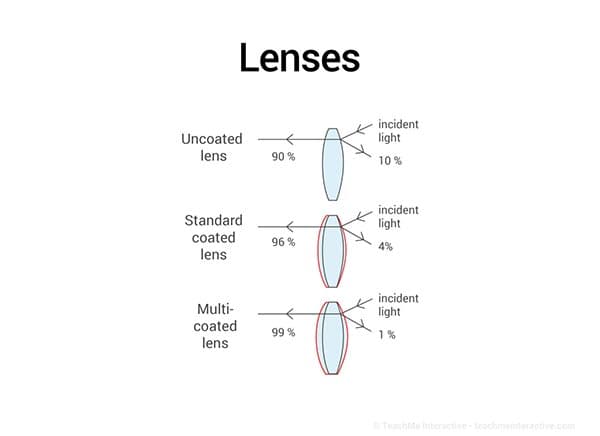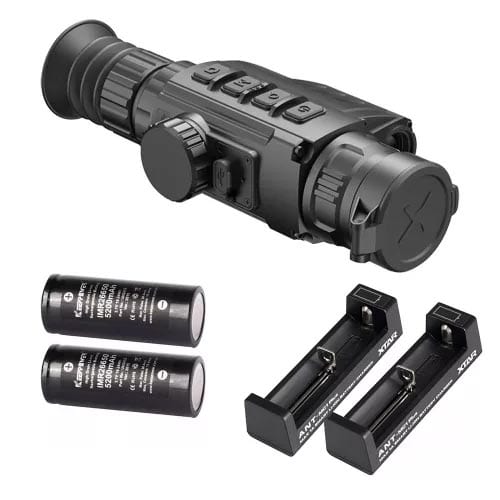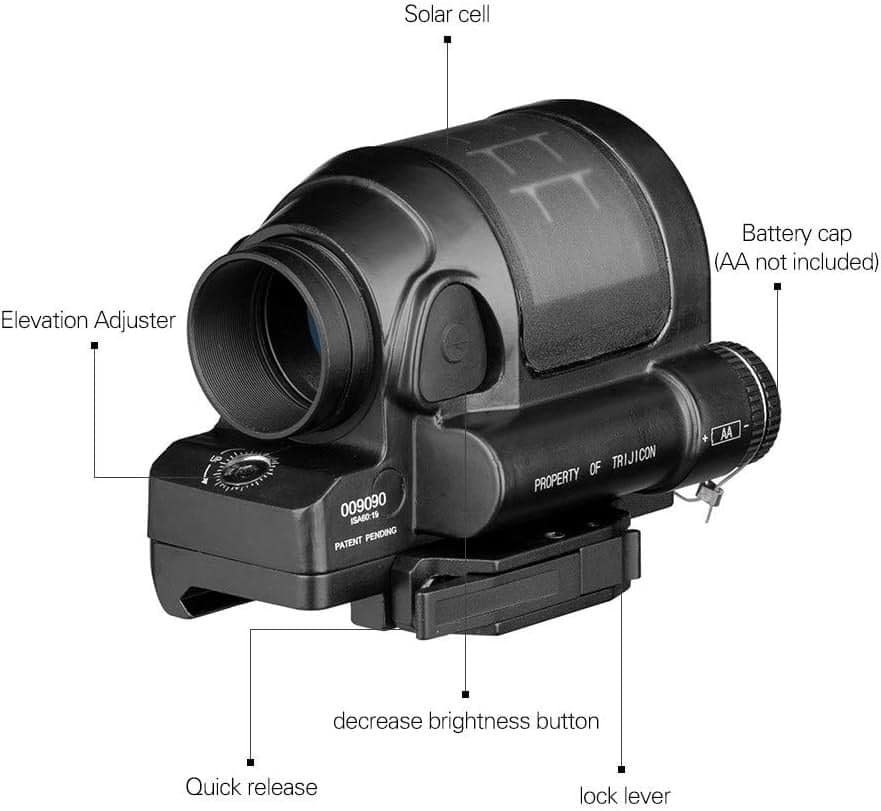Modern scopes, whether used in scientific research, surveillance, wildlife observation, or recreational activities, have undergone remarkable transformations in recent decades. These scopes, designed to enhance our ability to see and understand the world around us, now rely heavily on advanced technologies, including optics and electronics. However, at the heart of these technological marvels lies a crucial, often overlooked component: batteries. Batteries play an indispensable role in powering the optics and electronics that make modern scopes so effective and versatile.

Image: Rifleshootermag.com
- Evolution of Scopes
- Optical Components of Modern Rifle Scopes
- Electronic Components of Modern Rifle Scopes
- Role of Batteries in Modern Rifle Scopes
- Types Of Battery Technologies for Rifle Scopes
- Factors to Consider When Choosing Batteries for Modern Scopes
- Challenges and Solutions in Battery Use for Scopes
- Maintenance and Care of Batteries in Rifle Scopes:
- FAQs
- What is the purpose of batteries in modern rifle scopes?
- Which types of batteries are commonly used in rifle scopes?
- How do I choose the right battery for my rifle scope?
- What is the typical lifespan of batteries in rifle scopes?
- How can I extend the battery life in my rifle scope?
- What should I do if my scope’s battery dies during a shooting session?
- Are solar-powered scopes a reliable option for low-light conditions?
- Can I use rechargeable batteries in my rifle scope?
- Are there any safety precautions I should follow when handling rifle scope batteries?
Evolution of Scopes
The evolution of scopes is a journey through centuries of human curiosity and scientific progress. It traces the transformation of simple optical devices into the high-tech instruments we have today.
Scopes have ancient roots dating back to the invention of the telescope in the early 17th century. Pioneered by astronomers like Galileo Galilei and Johannes Kepler, these early telescopes used convex and concave lenses to magnify distant objects, revolutionizing our understanding of the cosmos. In the 17th century, the microscope was invented, allowing scientists to explore the world of the very small.
The 18th and 19th centuries witnessed significant improvements in telescopic technology. Refracting and reflecting telescopes emerged, expanding our view of the universe. The mid-20th century saw the integration of electronics into scopes. Night vision scopes and other electronic scopes emerged, providing new capabilities for military use and other applications. In recent decades, scopes have become increasingly digital with the integration of advanced features.
Optical Components of Modern Rifle Scopes
Modern rifle scopes are highly specialized optical instruments designed to enhance a shooter’s accuracy and precision. These scopes consist of a range of optical components that work together seamlessly to improve target acquisition and aiming.
Lenses and Coatings

Objective Lens: The objective lens is positioned at the front of the scope and plays a critical role in gathering light from the target and transmitting it through the scope. It determines the scope’s primary magnification.
Ocular Lens: The ocular lens, located at the rear of the scope, is the lens through which the shooter peers to view the target. It’s responsible for focusing the image produced by the objective lens.
Lens Coatings: To improve optical performance, lens surfaces are coated with special materials. Anti-reflective coatings reduce glare, improve light transmission, and enhance contrast in the image. Additionally, anti-scratch coatings protect the lenses from damage, while hydrophobic coatings repel moisture and dirt, keeping the lens clear.
Reticles and Crosshairs
Rifle scopes come equipped with a variety of reticle designs, each tailored to different shooting scenarios. Common reticle types include duplex, mil-dot, BDC (Bullet Drop Compensator), and illuminated reticles.
Illuminated Reticles: Many modern scopes feature illuminated reticles with adjustable brightness settings. These illuminated reticles aid shooters in low-light conditions by providing a visible aiming point.
Bullet Drop Compensation (BDC): BDC reticles are designed to assist shooters in compensating for the bullet’s drop at different distances. They have multiple aiming points or hash marks calibrated for specific ranges, allowing for quick and accurate adjustments.
Electronic Components of Modern Rifle Scopes
Illumination Systems
Many modern rifle scopes come equipped with illuminated reticles that offer several advantages. These systems use LED or fiber-optic technology to illuminate the reticle. Shooters can adjust the brightness to match the ambient light conditions, ensuring a clear and visible aiming point.
Digital Displays
High-end rifle scopes incorporate digital displays that offer shooters various forms of information. Digital readouts provide real-time feedback on adjustments, making it easier for shooters to zero their rifles and make precise corrections. Some scopes can display ballistic data, including holdover values or turret adjustments, based on the shooter’s specific ammunition and environmental conditions. Shooters can also customize the digital display settings, such as the brightness and unit of measurement, to align with their preferences and ballistic profiles.
Some scopes integrate rangefinder technology and display estimated target distances, while other have environmental sensors that provide data on temperature, humidity, and atmospheric pressure, allowing shooters to make more accurate long-range shots.
Adjustment Mechanisms
Rifle scopes are equipped with adjustment turrets to facilitate precise aiming adjustments. Turrets are typically marked in either Minutes of Angle (MOA) or Milliradians (MILs). These markings help shooters make accurate windage and elevation adjustments. Some scopes feature zero-reset turrets, which allow shooters to quickly return to their original zero settings after making adjustments. This feature is particularly useful when switching between different distances or targets.
High-end scopes may include a parallax adjustment turret or side knob, which eliminates parallax error, ensuring the reticle and the target remain on the same plane for improved accuracy, especially at longer distances.
Role of Batteries in Modern Rifle Scopes
Batteries play a crucial role in modern scopes, powering various electronic components and enhancing their overall functionality.
Power Illumination Systems
Many modern rifle scopes feature illuminated reticles with adjustable brightness levels. These reticles are powered by batteries and serve to improve target visibility in low-light conditions. Shooters can adjust the illumination level to match the ambient lighting, ensuring a clear and visible aiming point.
Impact on Reticle Visibility
Batteries have a direct impact on the visibility of the reticle. When the reticle is illuminated, it contrasts with the target background, making it easier for the shooter to center the crosshairs on the target.
Battery Life and Performance
The battery life of modern scopes varies depending on factors such as the type of battery used, the brightness setting of the reticle, and how frequently the scope is used. Shooters should monitor battery life to prevent unexpected power failures. It’s essential to choose high-quality batteries and replace them as needed to maintain consistent performance. Batteries nearing the end of their life may cause fluctuations in reticle brightness or unexpected power loss, which can affect shooting accuracy.
Red Dot Sights and Holographic Sights
Red dot sights are a type of rifle scope that often uses batteries to power the LED emitter responsible for projecting the red dot onto the sight’s lens. These sights are known for their quick target acquisition and are widely used in close-quarters shooting. Holographic sights, like red dot sights, typically rely on batteries to project a holographic reticle onto the sight’s lens.
Types Of Battery Technologies for Rifle Scopes
Battery technologies have evolved to provide reliable and long-lasting power sources for the electronic components in modern scopes.
Lithium-Ion Batteries

Advantages
Longevity: Lithium-ion batteries are renowned for their extended lifespan compared to many other battery types. They maintain their capacity and performance over a more extended period, making them an excellent choice for electronic devices that require consistent and long-term power. For rifle scopes, this means fewer battery replacements and reduced downtime.
High Energy Density: Lithium-ion batteries have a high energy density, meaning they can store a significant amount of energy in a relatively small and lightweight package. This characteristic is advantageous for scopes, especially compact models, as it allows them to maintain a slim profile while providing ample power to electronic components.
Rechargeable Options: Some rifle scopes are designed to accommodate rechargeable lithium-ion batteries. This feature not only contributes to cost savings over time but also reduces environmental waste associated with disposable batteries. Shooters can recharge the batteries using compatible chargers, ensuring that the scope remains powered without the need for frequent replacements.
Considerations
Cost: Lithium-ion batteries, especially the rechargeable variants, may have a higher upfront cost compared to disposable options like button cells. However, the long-term cost savings due to their extended lifespan and reusability often offset the initial expense.
Charging Requirements: Rechargeable lithium-ion batteries require specific chargers that are designed to handle their charging needs. Users must adhere to proper charging procedures, as mishandling or using incompatible chargers can lead to safety hazards or reduced battery performance. Additionally, shooters need to ensure they have access to a charger when needed.
CR2032 Button Cells
Advantages
Widely Available: CR2032 cells are one of the most commonly used coin-cell batteries and are readily available at most retail stores and online outlets. This widespread availability ensures that shooters can easily find replacement batteries when needed, reducing downtime.
Compact Size: CR2032 cells are compact and have a standard coin-cell shape, making them compatible with the battery compartments of most rifle scopes. Their small size ensures they can be conveniently inserted and replaced without taking up much space.
Low Self-Discharge: CR2032 cells have a low self-discharge rate, which means they can hold their charge for an extended period when not in use. This characteristic is advantageous for rifle scopes that may not be used frequently. Shooters can store their scopes for extended periods without worrying about the battery losing its charge.
Considerations
Limited Lifespan: One of the primary considerations with CR2032 cells is their limited lifespan compared to rechargeable lithium-ion batteries. Since button cells are typically disposable, shooters may need to replace them more frequently, depending on the frequency of scope usage. This can result in ongoing costs, especially if the scope is used extensively.
Not Rechargeable: CR2032 cells are not rechargeable. Once their capacity is depleted, they must be discarded and replaced with new batteries. This lack of reusability can lead to increased waste and may not be as environmentally friendly as rechargeable battery options.
Solar-Powered Options

ACEXIER Reflex Sight Solar Power System 1X38
Advantages
Extended Battery Life: Solar-powered rifle scopes have the significant advantage of extending battery life by harnessing sunlight or ambient light to power their electronic components. This reduces the frequency of battery replacements and minimizes the risk of running out of power during critical moments in the field.
Reduced Reliance on Disposable Batteries: Solar-powered scopes reduce the reliance on disposable batteries, making them environmentally friendly and cost-effective in the long run. This is especially advantageous for shooters who value sustainability and wish to minimize the environmental impact of their shooting activities.
Considerations
Dependence on Light Conditions: The primary consideration of solar-powered scopes is their dependence on adequate light conditions to function optimally. While they can operate in most daylight conditions, they may require a backup power source in situations of extremely low light, such as nighttime or when shooting indoors. Some models come with backup batteries to address this limitation.
Initial Cost: Scopes equipped with solar panels tend to have a higher upfront cost compared to scopes that rely solely on disposable batteries. The added technology and engineering required for solar integration contribute to this increased initial expense. However, it’s essential to weigh this cost against the potential long-term savings on disposable batteries.
Factors to Consider When Choosing Batteries for Modern Scopes
When choosing batteries for modern rifle scopes, several factors should be taken into consideration to ensure reliable and consistent performance. Here are the key factors to keep in mind:
Compatibility
Ensure that the selected battery type is compatible with your specific rifle scope model. Check the manufacturer’s recommendations and guidelines for the appropriate battery type and size.
Battery Life
Consider the expected battery life of the chosen battery type. Longer-lasting batteries, such as lithium-ion or those with low self-discharge rates, may be preferable for scopes used frequently, as they require fewer replacements.
Environmental Conditions
Assess the shooting environments you frequent. If you often shoot in low-light conditions or extreme temperatures, consider batteries that perform well in those conditions, such as lithium or lithium-ion batteries.
Availability
Consider the availability of the selected battery type. Ensure that replacement batteries are readily accessible and that you can easily find them at stores or online, especially if you’re going on extended shooting trips.
Rechargeable vs. Disposable
Decide whether you prefer rechargeable or disposable batteries. Rechargeable batteries, such as lithium-ion, may be more cost-effective in the long run but require compatible chargers and access to power sources for charging.
Cost
Factor in the cost of the batteries. While some options may have a higher upfront cost, consider the overall cost over time, including replacement batteries, to determine the most cost-effective choice.
Battery Type
Consider the specific battery type, such as lithium-ion, CR2032 button cells, or solar-powered options. Each type has its advantages and limitations, so choose the one that best aligns with your shooting needs and preferences.
Backup Power
If you shoot in low-light conditions or indoor environments, consider scopes with backup power options, such as solar panels or secondary batteries, to ensure uninterrupted operation.
Challenges and Solutions in Battery Use for Scopes
Dependence on Batteries
Rifle scopes with electronic components may become unusable if the battery dies in the field, potentially leaving shooters without a reliable aiming solution. Always carry spare batteries when using battery-powered scopes. Regularly check the battery status and replace batteries as needed. Opt for scopes with backup power sources like solar panels or secondary batteries to reduce this risk.
Environmental Factors
Extreme temperatures, humidity, and exposure to the elements can affect battery performance and lifespan. Store scopes properly to protect them from extreme conditions when not in use. Use batteries known for their reliability in varying environmental conditions, such as lithium batteries.
Battery Management
Keeping track of battery life and replacements for multiple scopes and devices can be challenging. Maintain a battery management system that includes labeling batteries with installation dates, regularly checking battery status, and having a supply of spare batteries on hand during shooting trips.
Battery Type Compatibility
Different scopes may require different battery types, making it inconvenient to stock and manage multiple battery types. Standardize your battery choices when possible. Choose scopes that use the same battery type to simplify inventory and management.
Charging and Maintenance
Rechargeable batteries require proper charging and maintenance to maximize their lifespan. Follow the manufacturer’s guidelines for charging rechargeable batteries and avoid overcharging. Use compatible chargers and maintain a regular charging schedule.
Maintenance and Care of Batteries in Rifle Scopes:
Battery maintenance is crucial to ensure the reliable operation of electronic components in rifle scopes. Proper care can extend battery life and prevent unexpected power failures.
Proper Battery Installation
Follow Manufacturer Instructions: Always adhere to the manufacturer’s instructions regarding battery installation. Review the user manual for specific guidance on inserting and securing the battery in your rifle scope.
Check Polarity: Pay attention to the battery’s polarity (positive and negative terminals). Ensure that you insert the battery in the correct orientation as indicated in the scope’s battery compartment.
Clean Contacts: Periodically inspect the battery contacts in both the battery compartment and the cap or cover. Clean any corrosion or dirt using a clean, dry cloth or a soft brush. Dirty or corroded contacts can hinder electrical connections.
Battery Replacement and Lifespan
Monitor Battery Life: Keep track of your battery’s lifespan. Some scopes provide a low-battery indicator or an estimated remaining battery life feature. Regularly check the status of your battery.
Replace on Schedule: Replace batteries proactively rather than waiting for them to completely run out. Set a schedule for battery replacement based on your scope’s power consumption and the type of battery used.
Use Quality Batteries: Opt for reputable battery brands known for their reliability and performance. Quality batteries often have more consistent power output and longer lifespans.
Storage Considerations
Remove Batteries for Long-Term Storage: When you anticipate not using your rifle scope for an extended period, such as during the off-season, it’s advisable to remove the batteries. This precaution helps prevent potential leakage and damage to the scope’s electronics. Even when the scope is turned off, some electronic components may draw a small amount of power, leading to premature battery depletion.
Store Batteries Separately: Storing your rifle scope together with batteries inside might not be a good idea. It is advisable to remove the batteries during storage and keep them separately.
FAQs
What is the purpose of batteries in modern rifle scopes?
Batteries in modern scopes have a vital role. They power important electronic features like illuminated crosshairs, digital readouts, and adjustment mechanisms. These features improve your ability to aim accurately and enhance the overall performance of the scope.
Which types of batteries are commonly used in rifle scopes?
Commonly used batteries for rifle scopes include lithium-ion batteries and CR2032 button cells (like those in some watches), and some scopes even have solar-powered options.
How do I choose the right battery for my rifle scope?
Picking the right battery involves considering a few things. First, make sure it’s compatible with your scope. Then, think about how long it lasts, how often you’ll use it, where you’ll use it (like extreme weather conditions), and how easy it is to find in stores or online.
What is the typical lifespan of batteries in rifle scopes?
The lifespan of scope batteries varies depending on how often you use them and the type of battery. Lithium-ion batteries generally last longer than disposable button cells. It’s a good idea to check your battery regularly and replace it as needed.
How can I extend the battery life in my rifle scope?
Use good-quality batteries because they often provide more consistent power. When you’re not using your scope for a while, store it in a cool, dry place to preserve the battery.
What should I do if my scope’s battery dies during a shooting session?
Always carry extra batteries with you when you’re out shooting. If your battery dies unexpectedly, replace it right away so you can keep using your scope without interruptions.
Are solar-powered scopes a reliable option for low-light conditions?
Solar-powered scopes can be great for extending battery life, but they might not work well in very dark conditions or indoors. Some models come with backup batteries to help in low-light situations.
Can I use rechargeable batteries in my rifle scope?
Yes, you can. Some scopes can use rechargeable lithium-ion batteries, saving you money compared to disposable ones. But make sure to follow the manufacturer’s instructions for using rechargeable batteries to avoid problems.
Are there any safety precautions I should follow when handling rifle scope batteries?
When dealing with batteries for your scope, handle them carefully. Avoid exposing them to extreme temperatures, and always use the right charging and storage methods recommended by the manufacturer. This ensures both safety and the best performance from your batteries.

Mike Hardesty is a published freelance gun writer. He also possesses specialized expertise in rifle scopes With dozens of articles and reviews published in Pew Pew Tactical, Snipercountry.com, and TTAG (The Truth About Guns), Mike is considered a firearms expert. His special area of expertise is handguns.
Mike is a long-time shooter. He has been punching paper targets, taking deer and other game and shooting at competitions since about 1975. Other related pursuits include reloading and bullet casting. He currently reloads for over 10 calibers, both handgun and rifle. His reloads, particularly for 9mm, were in great demand during the height of the ammo shortage among family and friends. He donated hundreds of rounds to informal shooting sessions. He was quoted as saying “I do not sell my reloads but I sure will help my guys shoot ’em for free!”. He has a few cherished firearms that he has inherited or otherwise procured — those are his favorites.
He earned B.S. and M.S. degrees from Indiana State University in 1974-1975.
He’s a firearm experts and is the founder of mhardesty.com.
